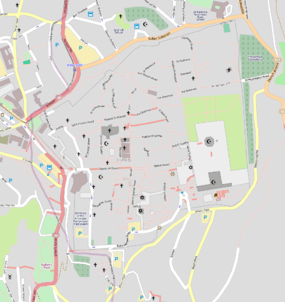Lions' Gate
| Lions' Gate | |
|---|---|
|
Lions' Gate | |
 Location in Old Jerusalem | |
| General information | |
| Town or city | Jerusalem |
| Coordinates | 31°46′51″N 35°14′13″E / 31.78083°N 35.23694°E |
The Lions' Gate (Hebrew: שער האריות Sha'ar ha-Arayot, Arabic: باب الأسباط, also St. Stephen's Gate or Sheep Gate) is located in the Old City Walls of Jerusalem, and is one of seven open Gates in Jerusalem's Old City Walls.
During the Crusader period, the gate was known as Josophat's Gate.[2]
Located in the east wall, the entrance marks the beginning of the traditional Christian observance of the last walk of Jesus from prison to crucifixion, the Via Dolorosa. Near the gate’s crest are four figures of leopards, often mistaken for lions, two on the left and two on the right. They were placed there by Sultan Suleiman the Magnificent to celebrate the Ottoman defeat of the Mamluks in 1517. Legend has it that Suleiman's predecessor Selim I dreamed of lions that were going to eat him because of his plans to level the city. He was spared only after promising to protect the city by building a wall around it. This led to the lion becoming the heraldic symbol of Jerusalem.[3] On the other hand Bahat notes that panthers were earlier the heraldic insignia of Baybars and suggests that they were transferred to Jerusalem from a different building in the 16th century.[4]
In another version, Suleiman taxed Jerusalem's residents with heavy taxes which they could not afford to pay. That night Suleiman had a dream of two lions coming to devour him. When he woke up, he asked his dream solvers what his dream meant. A wise respected man came forward and asked Suleiman what was on his mind before drifting to sleep. Suleiman responded that he was thinking about how to punish all the men who didn't pay his taxes. The wise man responded that since Suleiman thought badly about the holy city, God was angry. To atone, Suleiman built the Lions' Gate to protect Jerusalem from invaders.
Israeli paratroops from the 55th Paratroop Brigade came through this gate during the Six-Day War of 1967 and unfurled the Israeli flag above the Temple Mount.
The Lions' Gate is not to be confused with the Zion Gate in the Old City Wall, located in the south, leading to the Jewish and Armenian Quarters.
The magnificent walls of Jerusalem's Old City were built by the Ottoman Empire under the direct supervision of Sultan Suleiman in 1542. The walls stretch for approximately 4.5 kilometers (2.8 mi) and rise to a height of 5–15 meters (16–49 ft), with a thickness of 3 meters (9.8 feet).[5] All together, the Old City walls contain 43 surveillance towers and 11 gates, seven of which are presently open.
References
- ↑ Jerusalem municipality website
- ↑ A. J. Boas. Crusader Archaeology. p. 14.
- ↑ Jerome Murphy-O'Connor, The Holy Land: an Oxford archaeological guide from earliest times to 1700, 2008, p. 21, ISBN 978-0-19-923666-4
- ↑ Dan Bahat. The Illustrated Atlas of Jerusalem. p. 110.
- ↑ The Jerusalem Post Millennium Special
See also
External links
| Wikimedia Commons has media related to Lions Gate. |
Coordinates: 31°46′51″N 35°14′13″E / 31.78083°N 35.23694°E
